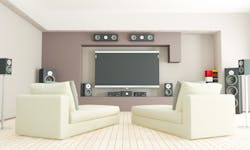As trite and obvious as it may sound, a new year brings with it new opportunities, and dare we say even new technologies. As the connected home becomes more and more accessible your company may be noticing an increased demand for services outside the security realm.
Sure, your client meeting may start with the basics of locks, cameras and alarms, but the discussion could quickly evolve to adding in some audio zones, or a home theater, or even a full home automation system. The simple truth is, you are already in the home — you have earned the client’s trust. So why hand off the project to someone else and leave money on the table?
The question then becomes: Are you ready? If you are just starting to dip your toe in this pool, here’s breakdown on a few key topics:
Home Audio
Obviously there is a lot to know about audio, from speaker placement to audio signals, perhaps even more importantly, the consumer demand is there. According to CEDIA’s annual Size and Scope of the Residential Electronic Systems Market research report, distributed audio installations including internet connected wireless speakers increased from 16 percent in 2012 to an expected 26 percent in 2014. This was coupled with an increase in the number of respondents that believe these products will help their business from direct consumer demand.
If you are going to start offering audio and wireless audio, there are some things you should know. I spoke to Jim Venable of the Wireless Speaker and Audio (WiSA) Association about what clients expect from both installers and the wireless products they choose.
“Consumers are looking for several things but by and large, first they want to match the quality of the audio with the quality of the video in their home theater or living room,” Venable explains. “Next is flexibility — having the ability to rearrange a room or move furniture around without having to call a home technology professional to re-run wire is important.
“Additionally, consumers want the system to be scalable — having the ability to add speakers like rears or surrounds when it makes sense for them to do so,” he continues. “Some consumers are choosy about the brand and type of speakers they want for their home entertainment. Having the freedom to mix and match speakers and components from different manufacturers is a huge advantage for compatible wireless speakers.
“Finally, consumers want peace of mind,” Venable concludes. “They want their speakers to be reliable, interference-free and easy to use. Their experience with wireless speakers in the past wasn’t very good, and for them to make the leap again, they will need to have confidence that when the system gets installed it will work and work well beyond when the installer leaves.”
The past year has also seen some exciting developments in the field of surround sound audio. A new surround sound format has emerged and it is object-based rather than channel-based, and can support up to 34 speakers. What exactly does that mean?
Where traditional surround sound formats are heard on speaker channels — this new format is based on audio objects and their specific sounds that are heard around the room creating an immersive experience. Immersive, object-based audio is a development that has home technology professionals very excited. It offers opportunities for upgrades and is being hailed as the biggest advancement since Dolby Digital.
The Home Theater
For many, the phrase “home theater” conjures images of a space in a ritzy house that is dark with a big screen and theater-style seating; however a new trend is emerging where more home theater installations are being done in open spaces like living and family rooms.
What’s appropriate for your client? There are many factors to take into account. The dedicated home theater space lends itself to a system designed to deliver ultimate performance. If they are looking for a no-holds-barred home theater installation, the dedicated space is likely the way to go. On the other hand, a media room is more inviting than a closed-in, darkened home theater. With seating typically in the form of couches and love seats, the viewing experience is more social.
Regardless of the option your client is considering, chances are they are going to ask you about Ultra HD/4K — and it can be hard to decipher the jargon and tech specs from what you actually need to relay to your clients.
The term “4K” is probably the one best known within the industry and has been thrown around to describe a variety of different resolution formats; however, the correct specification for 4K comes from the commercial world and our friends in digital cinema. A true 4K picture (sometimes called 4K x 2K) has a resolution of 4096x2160, which amounts to an aspect ratio of approximately 17/9 or 1.89:1 (a ratio commonly used for widescreen films). Thus, the more appropriate term to use is Ultra HD (sometimes referred to as QFHD or Quad Full HD). Lots of terms have gone around, but it seems that UHD or Ultra HD will be the term accepted by most manufacturers for residential televisions.
In order for a display to meet the minimum requirement to be considered UHD, it must have twice the vertical and horizontal resolution of Full HD, which translates to 3840x2160 pixels (over 8 million individual pixels as compared to a current HD display that has just over 2 million pixels), and an aspect ratio of at least 16/9 (1.78:1).
While UHD and 4K displays and even projectors now hit the market, it appears that penetration into homes may be faster than many expected. The rationale for quicker adoption rates for UHD/4K displays is strictly based on price. There are several very aggressive manufacturers who are selling or announced the will be selling UHD/4K flat panels at costs comparable to existing LCDs and plasmas. However, one must pay close attention to the actual specs, and more importantly performance, of these displays. As of right now, not all UHD/4K displays are created equal, as some will have UHD capability but not have the ability to up-convert or scale non-UHD content — and thus may display lower resolution content poorly.
It will be up to you as the authority on the displays you are selling and installing to be able to discern the difference — and for some time, there will be a measurable difference between brands and models.
Training Resources
Before you can jump into the deep end with audio, home theaters or media rooms, there are a few ways to get a handle on the basics. The CEDIA resource library (www.cedia.net/train/resources) houses various eCourses on audio — including a three-part course featuring industry legend Dr. Floyd Toole.
The basics of audio and home theaters and media rooms are also widely covered in the Fundamentals of Residential Electronic Systems book as well as the Electronic Systems Technical Reference Manual, also available for purchase in the CEDIA resource library.
If you are more of a hands-on learner, there is no better place to get a grasp on these topics than Home Theater Boot Camp held at CEDIA HQ in Indianapolis. Visit cedia.net to check out all the resources, dates for Boot Camp and more.
Olivia Sellke is the Communications Manager for CEDIA (www.cedia.net).


